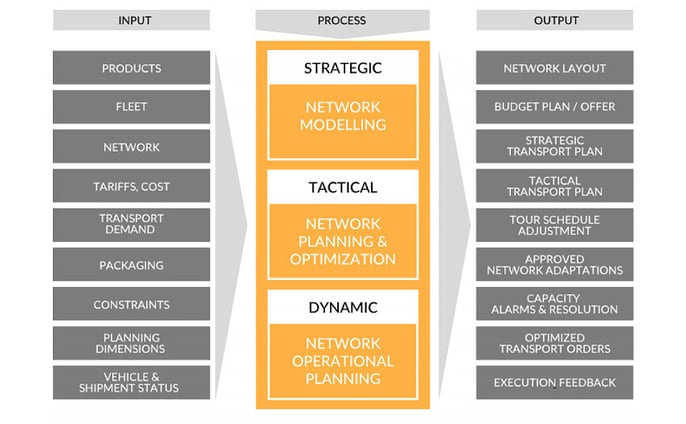Boost Your Supply Chain Planning with 6 New Technologies
Keith LaBotz - May 04, 2023

Supply chain planning does more than increase efficiency and enable automation - it will determine your company’s future. Choosing the right technology and partner is vital to creating an effective Supply Chain Management (SCM) planning process, and knowing which technologies to focus on can make all the difference.
According to a recent Gartner® report, that’s a top challenge for companies, and supply chain leaders are pursuing a wide range of technologies to increase supply chain visibility and automation. The goal is to optimize the supply chain process, which requires a dynamic SCM planning solution that automatically updates as conditions change.
Focusing efforts on the most effective technologies can save time when finding the best-fit planning solution and provider, significantly boosting the effectiveness of SCM planning.
Six technologies noted in Gartner® findings can help your company accomplish that, and this post will outline them along with foundational requirements.
The Most Important Step: SCM Planning Requirements
Digitally transforming the planning process depends on clearly understanding business requirements so they can be operationalized - digitally introduced into the technologies used. The effort invested into these requirements will determine how effectively the technologies perform:
-
A clear supply chain strategy, objectives, and business priorities to guide systems implementation. Short-term operational objectives must be aligned with broader strategic goals.
-
A data model representing a company’s business model, use-case scenarios, and strategic objectives.
-
Understand interdependencies between finance, demand, production, and distribution cross-functional activities to ensure alignment in companywide decision-making and collaboration.
-
Identify a provider with a solution with robust what-if analysis capabilities and systems integration to operationalize previously mentioned requirements.
1: Cloud Computing
Cloud computing delivers access to digital services over the Internet, making it easier to expand functionality and data access around a supply chain digital twin. A cloud SCM planning solution accelerates the implementation of proven solutions without risking disrupting existing enterprise systems.
2. Supply Chain Digital Twin
A supply chain digital twin provides a virtual replica of the supply chain for simulating real-world scenarios. It is also the foundation for end-to-end visibility, integrating data from multiple systems across the network into a coherent view for analytics. What-if analysis of a company’s use case scenarios run against the digital twin assesses the impact of potential plan changes, resulting in faster, better decisions.
3: Internet of Things (IoT)
IoT sensors allow tracking of goods and vehicles moving through a supply chain, providing real-time visibility to a digital twin. They are inexpensive and easy to deploy wherever timing windows are critical to planning, and data can be shared with partners to improve collaboration.
4: Autonomous Things
These physical devices perform tasks without human intervention and are not subject to labor-related constraints, such as overtime and driver Hours of Service regulations. With fewer constraints, the potential for optimization greatly expands, boosting performance and profits.
Examples in logistics include autonomous vehicles, drones, and warehouse robots. Equipped with onboard sensors, decision logic, and IoT technology, these digital workers collect data when executing tasks.
5: Artificial Intelligence (AI)
AI drives faster, better decisions with data-driven algorithms and statistical models that can analyze large data sets, like those in a supply chain digital twin. It can find hidden correlations, trends, and constraints, resulting in more effective planning. For example, automating demand forecasting can optimize inventory levels, production schedules, and transportation planning as demand and transportation capacity fluctuate.
6: Big Data Analytics
Big data analytics extends AI’s analysis across networks to bolster planning and supply chain performance. It can uncover hidden patterns, correlations, and insights in large, complex, disparate data sets to improve decision-making.
How flexis Leverages These 6 Technologies to Boost SCM Planning
flexis AG is an example of a solution provider with SCM planning expertise and products meeting the requirements.

The flexis suite of planning solutions runs parallel to existing enterprise systems, dynamically updating operational planning as capacity and supply chain constraints change.
- Supply chain planning aligns strategic, tactical, and daily objectives with cross-functional and corporate goals.
- Simulations run continuously to calculate risks, opportunities, and use case scenarios as conditions change in the supply chain.
- Organizations typically utilize flexis’ solutions in the cloud (1), utilizing a digital twin (2) to provide visibility to key events and analyze multiple supply chain functions.
- Data is collected from enterprise systems such as S&OP, ERP, and TMS software, autonomous devices (3), IoT (4), tracking sensors on products at various production and shipping stages, and external data servers like transportation providers, enabling big data analytics (5).
- flexis solutions employ artificial intelligence (6), like machine learning and predictive analytics, to identify patterns and update planning and schedules to synchronize operations across a supply chain.
Conclusion
Focusing on the six technologies outlined can lead you to the best planning solution and partner for your company, boosting the effectiveness of SCM planning. flexis AG helps companies of all sizes get the most from supply chain planning by utilizing the technologies described in this article.
If you want to learn more get your Guide to Logistics 4.0
In this Guide you will learn:
-
Why a strategic process in transportation planning is a top priority for digitalization
-
What megatrends will increase supply chain volatility
-
How to manage it
LATEST POSTS
- Understand Circular Economy in The Manufacturing Industry
- How Can Industry 4.0 IT Integration Be Achieved Smoothly?
- The Significance of Order Sequencing in Discrete Manufacturing
- How to improve your Supply Chain Management: The Power of Control Towers
- Optimizing Human Resource Scheduling in Manufacturing: A Technological Approach



